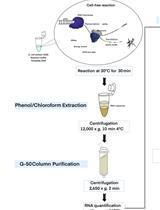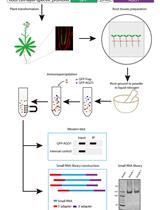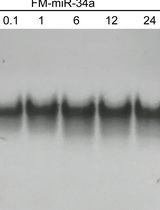- EN - English
- CN - 中文
Successful Transfection of MicroRNA Mimics or Inhibitors in a Regular Cell Line and in Primary Cells Derived from Patients with Rheumatoid Arthritis
在常规细胞系和源自类风湿性关节炎患者的原代细胞中成功转染 MicroRNA 模拟物或抑制剂
发布: 2023年09月20日第13卷第18期 DOI: 10.21769/BioProtoc.4823 浏览次数: 1840
评审: Navnita DuttaAnonymous reviewer(s)
Abstract
The transfection of microRNA (miRNA) mimics and inhibitors can lead to the gain and loss of intracellular miRNA function, helping us better understand the role of miRNA during gene expression regulation under specific physical conditions. Our previous research has confirmed the efficiency and convenience of using liposomes to transfect miRNA mimics or inhibitors. This work uses miR-424 as an example, to provide a detailed introduction for the transfection process of miRNA mimics and inhibitors in the regular SW982 cell line and primary rheumatoid arthritis synovial fibroblasts (RASF) cells from patients by using lipofection, which can also serve as a reference to miRNA transfection in other cell lines.
Key features
• MiRNA mimics and inhibitors transfection in regular SW982 cell line and primary RASF cells.
• Treatment and culture of RASF primary cells before transfection.
Using liposomes for transfection purposes.
Keywords: miRNA (miRNA)Background
Transfection is a specialized technique for introducing exogenous genes into cells. With the deepening of research on gene and protein functions, transfection has become a common basic method in laboratory work. Transfection can be roughly divided into three methods: physical, chemical, and biological mediation. Electroporation, microinjection, and gene gun are very promising physical methods. There are also many chemical methods, such as the classical calcium phosphate coprecipitation method and the lipofection method. Biological methods include primitive protoplast transfection and various virus-mediated transfection techniques (Kim and Eberwine, 2010).
Lipofection refers to the cationic liposome with a positive charge on the surface, which can interact with the phosphate group of nucleic acid through electrostatic interactions to encapsulate DNA or RNA molecules, forming lipid complexes. It can also be adsorbed by negatively charged cell membranes on the surface and then enter cells through fusion or endocytosis. Lipofection is suitable for transfect DNA or RNA into suspension or adherent cultured cells, and is currently one of the most convenient and efficient transfection methods in the laboratory (Felgner et al., 1987).
MicroRNAs (miRNAs) are a class of non-coding small RNAs composed of 18–25 nucleotides. Mostly, they regulate the expression of various protein cod genes at the post-transcriptional level, by inhibiting translation or inducing mRNA degradation, and have a significant impact on physiological processes such as cell differentiation, proliferation, apoptosis, and hematopoiesis. Hence, abnormal expression of miRNA is pathological and can result in the development and progression of multiple diseases (Bartel, 2004).
Some studies have found multiple miRNA expression disorders in rheumatoid arthritis (RA) patients, suggesting that an abnormal miRNA expression may be the molecular mechanism of the disease. These studies involve various cellular biological behaviors, as well as the regulation of signaling pathways and the study of target genes. With the expansion of research fields, the important role of miRNA in RA is gradually receiving increased attention. For example, miR-18a was found to be an inhibitor of nuclear factor kappa-B (NF-κB) in rheumatoid arthritis synovial fibroblasts (RASF) (Trenkmann et al., 2013); miR-19a is associated with the expression of Toll-like receptors in RASF (Philippe et al., 2012); and miR-23b is related to the expression of various inflammatory cytokines in RASF (Zhu et al., 2012).
As a key cell type in the research of pathogenesis of rheumatoid arthritis, the excessive proliferation and limited apoptosis of RASFs are considered to be the pathological basis of RA, which can directly promote joint destruction and cartilage damage by enhancing the production of matrix degrading enzymes (van der Helm-van Mil and Huizinga, 2008; Bartok and Firestein, 2010). Mimics and inhibitors of miRNAs were transfected into the regular SW982 cell line and the primary RASF cells from patients to study the molecular mechanism of these miRNAs during gain and loss of their function.
Materials and reagents
Biological materials
SW982 cell line (ATCC, catalog number: HTB-93)
RASF primary cell (origin)
Reagents
LipofectamineTM 3000 (Invitrogen, catalog number: L300001)
Mimics and inhibitors (GenePharma company, catalog number: B02001, B03001)
0.25% Trypsin-EDTA (HyClone, catalog number: SH30042.01B)
Fetal bovine serum (FBS) (Sangon biotechnology, catalog number: E51002)
DMEM high glucose culture medium (HyClone, catalog number: SH30022.01B)
Penicillin-Streptomycin 100× (P/S) (HyClone, catalog number: SV30010)
Saline (CR double-crane, catalog number: H20054037)
Phosphate buffered saline (PBS) (Biosharp, catalog number: BL601A)
DNase (Sigma-Aldrich, catalog number: AMPD1)
Hyaluronidase (Sigma-Aldrich, catalog number: 37259-53-3)
Type I collagenase (Sigma-Aldrich, catalog number: SCR103)
TRIzol reagent (Invitrogen, catalog number: 15596-026)
Pierce RIPA buffer (Thermo, catalog number: 89900)
NaOH (Xilong chemistry, catalog number: 7697-37-2)
HCI (Xilong chemistry, catalog number: 121-23-1)
Solutions
SW982 and RASF cell culture medium (see Recipes)
Recipes
SW982 and RASF cell culture medium
Reagent Final concentration Volume DMEM high glucose medium n/a 450 mL Fetal bovine serum 10% 50 mL P/S 0.1% 0.5 mL Total n/a 500.5 mL Adjust the pH with NaOH or HCl to 7.2–7.4.
Serum-free DMEM medium refers to the medium without the addition of FBS and antibiotics (the basal medium).
Laboratory supplies
100 mm sterile polystyrene culture dish (Nunc, catalog number: 150340)
6-well sterile polystyrene cell culture plate (Nunc, catalog number: 150239)
15 mL sterile centrifuge tube (KIRGEN, catalog number: KG2611)
1.5 mL centrifuge tube (KIRGEN, catalog number: KG2211S)
Ophthalmic scissors (Shinva, catalog number: ZC056R)
Hemacytometer (Bio-Rad, catalog number: 1450011)
Cell culture flask (Nunc, catalog number: 156340)
Equipment
Cell culture incubator: 37 and 5% CO2 (Thermo, catalog number: THM#3427)
Centrifuge (Eppendorf, catalog number: 5810R)
Biological safety cabinetry (Biobase, catalog number: BSC-1500IIB2-X)
Microscope (Nikon, catalog number: Eclipse E200)
Procedure
文章信息
版权信息
© 2023 The Author(s); This is an open access article under the CC BY-NC license (https://creativecommons.org/licenses/by-nc/4.0/).
如何引用
Wang, S., Xu, J., Guo, Y., Cai, Y., Zhu, W., Meng, L., Jiang, C. and Lu, S. (2023). Successful Transfection of MicroRNA Mimics or Inhibitors in a Regular Cell Line and in Primary Cells Derived from Patients with Rheumatoid Arthritis. Bio-protocol 13(18): e4823. DOI: 10.21769/BioProtoc.4823.
分类
分子生物学 > RNA > miRNA 干扰
您对这篇实验方法有问题吗?
在此处发布您的问题,我们将邀请本文作者来回答。同时,我们会将您的问题发布到Bio-protocol Exchange,以便寻求社区成员的帮助。
Share
Bluesky
X
Copy link













